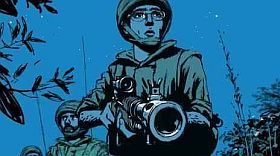


Waltz with Bashir

Sevara Pan writes this in-depth review of a film, that has become a classic within the animation doc genre. For those who are interested there is at the end of the article a link to a review written on filmkommentaren from 2008.
“Whether an eternity or just a minute, there was Frenkel at the junction with bullets flying past him in every direction. Instead of crossing the juction, I saw him dancing, as if in a trance. He cursed the shooters. Like he wanted to stay there forever. As if he wanted to show off his waltz amid the gunfire, with the posters of Bashir above his head. And Bashir’s followers preparing their big revenge just 200 yards away: the Sabra and Shatila massacre.”
Terrifying yet strangely beautiful, the scene haunts you as you sink into the story. Waltz with Bashir, an animated documentary directed by an Israeli filmmaker Ari Folman and co-produced by ARTE France and ITVS International, is not what one would call a piece of investigative journalism on war. Rather a collage-memoir and an indelible snapshot of the 1982 Lebanese war, the film flaunts its astounding graphics and poetry of language, not bereft of depth of tropes and figures of rhetorics. Above all, the film is an odyssey of a man, ravenous for every crumb of his past. Narrative, abstraction, speed, movement, stillness, life, death – they are all there. And much like Folman, we find ourselves at the urge to explore and maybe to find some kind of peace at the heart of it.
The film opens with the scene of the running savage dogs. Disoriented, we are prompty brought back to the urban setting of a bar, where the director is conversing with his comrade, a man with whom he did military service. Over a drink, the man named Boaz shares his recurring dream about being chased by 26 savage dogs and explains how the dream relates to the Lebanese war. For the first time in 20 years, this conversation inexplicably triggers a flashback of the war in Folman, too – a dreamscape of his younger self and his fellow comrades, emerging from the sea and wading onto the beach of Beirut. Yet, his memory falls silent when faced aghast. From this point onwards, Folman becomes fixated on the idea of reconstructing his memory of that war. Somewhere between recollections of his comrades and psychoanalysis of his therapist, he attempts to fill in the holes of his sieved memory. As he meets people and hears stories, he is starting to remember. “But isn’t that dangerous? he wonders. Maybe, I’ll discover things I don’t want to know about myself?”
Memory is fascinating. It is dynamic. It’s alive. The film reworks the notion of memory and carries it through the narrative. “But how is it possible not to remember such dramatic events?” Folman catechizes. “We call them dissociative events,” his psychotherapist explains. “It’s when a person is
in a situation but feels outside of it. I once was visited by a man, amateur photographer. I asked him in 1983, ‘How did you survive through that grueling war?’ He said, he looked at everything as if through an imaginary camera. Then something happened: his ‘camera’ broke […].”
And Folman’s ‘camera’ broke, too. Some would say that the film does not convey an objective war picture. I believe, it was not in the Folman’s ambition. The accounts of war are never detached or evenhanded. Its memories are mostly broken, fractured, and discarded as residues of first unresponded love – agonizing, illogical, and utterly devastating. Its remains are guilt-ridden and swept deep into the corners of the human mind.
“Then it happened in a taxi to Amsterdam airport,” Folman shares. “Suddenly, all the memories came back. Not a hallucination, not my subconscious. The first day of the war. Barely 19, I haven’t even started shaving. We are driving down a road. […] I had never seen an open wound or any kind of bleeding before. Now, I was in command of a tank, full of the dead and wounded, looking for a bright light, salvation. ‘What should we do? Why don’t you tell us what to do?’ others interpellated. ‘Shoot,’ I commanded. ‘At who?’ they asked again. ‘How do I know? Just shoot.’ I uttered. ‘Isn’t it better to pray?’ they asked at last. ‘Then, pray and shoot,’ I alleged.”
In the war where the helicopter lights are halos and the questions are asked postscriptum, the line between sanity and absurdity is washed-out. The sense of absurdity to the verge of hysteria and unbridled fear. “We were shooting like lunatics,” one of Folman’s comrades shares. “Two years of training and the fear, the uncontrollable fear […].”
One of the men then talks about a ‘slaughterhouse’ where the Palestinians are interrogated and executed. Hinting to the Salvador Dali’s painting The Persistence of Memory, the scene forges a surreal imagery and a distortive dreamwork. “It was like being on an LSD trip,” the man explains. “They carried body parts of murdered Palestinians, preserved in jars of formaldehyde. They had fingers, eyeballs, anything you wanted. And always pictures of Bashir. Bashir pendants, Bashir watches, Bashir this, Bashir that. Bashir was to them what David Bowie was to me. A star, an idol, a prince, admirable. I think, they even felt an eroticism for him. Totally erotic […].”
Through a trip-down memory lane of personal accounts and vestigial traces of the Lebanese war, Folman managed to piece together the picture of his role in the war, violently effaced by his memory. Somewhere in a deep labyrinth of himself, barricaded into a dark room of denial, he climbed over the temporal barriers in a pursuit to find the answers. His confusions inform the very foundation of the film. The fog of the war in his memory was created as a way of not facing up to the guilt, the guilt of witnessing a genocide, the guilt of an indirect complicity in the massacre of the refugees.
There is a sharp shift from animation to the live-footage in the last scene of the film as if to boost the truth factor of the documentary. A tad redundant and visually disrupting, I would say. Powerful, nevertheless. And with relentless and unremitting intensity, Waltz with Bashir takes us back to the core of who we are: “Inside the camp we saw a huge amount of rubble. My eye caught a hand, a small hand. A child’s hand stuck out from the rubble. I looked a bit closer and saw curls. A head of curls covered in dust. It was hard to make out. But it was a head, exposed up to the nose. A hand and a head. My own daughter was the same age as that little girl. And she had curly hair, too.”